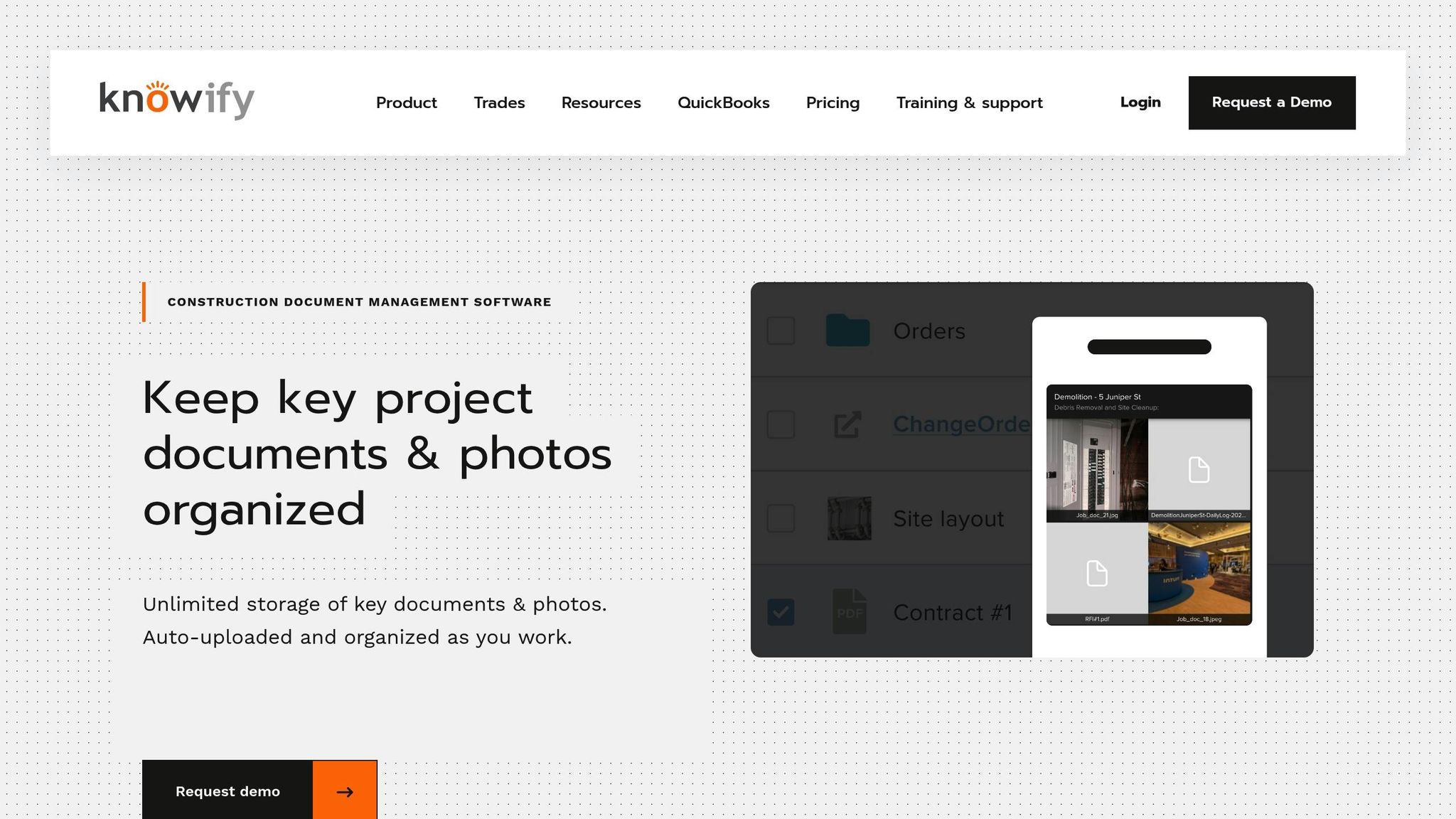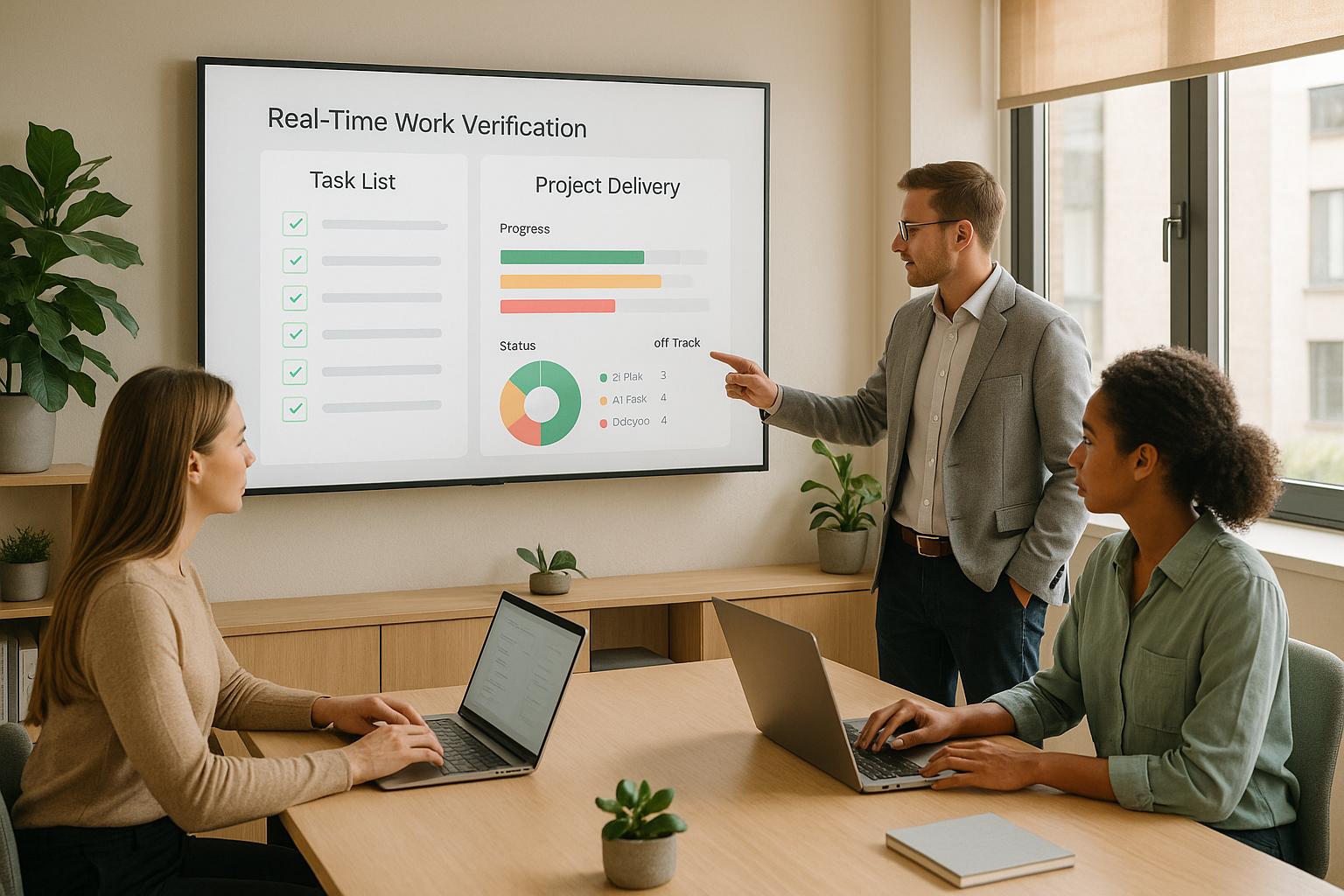Managing subcontractor approvals remotely doesn’t have to be complicated. Here’s a quick guide to help you streamline the process:
- Set clear standards: Define measurable expectations for quality, timelines, budgets, and reporting.
- Simplify submissions: Provide checklists and clear instructions to avoid errors and delays.
- Leverage technology: Use tools like WhatsApp for communication and platforms like Workproofs.com for quick, trackable approvals.
- Train subcontractors: Ensure they understand your processes and expectations through proper onboarding.
- Document everything: Keep written records of communications, approvals, and milestones to avoid disputes.
Submittals | Send for approval | Knowify

How to Set Up a Remote Approval System
Creating an efficient remote approval system starts with building a straightforward framework that ensures accountability. From there, you’ll need to define specific standards, simplify the submission process, and provide proper training to your team for smooth operations.
Set Clear Approval Standards
Start by setting measurable standards for every deliverable. These should cover scope, timelines, budget, quality, safety, reporting procedures, and communication protocols. For instance, construction projects might require specific photo angles and lighting, while creative tasks may need particular file formats and resolution requirements.
Another critical step is to establish monetary thresholds for different levels of approval. Nadia Louis Hermez, Legal Ops Manager at Next Insurance, Inc., explains:
"There is a stratification based on the contract value [at my organization]. We have set monetary thresholds. When the contract value exceeds that number, the contract goes through a strict review and approval process, and only certain authorized signatories can approve that contract."
This tiered approach ensures high-value projects receive the oversight they need, while smaller tasks can move forward without unnecessary delays.
Write Simple Submission Instructions
Clear submission guidelines are a must to avoid mistakes and delays. Create a detailed checklist outlining all required documents, photos, and information for approvals. For example, Fabcon Structural cut claim processing time by 40% after standardizing their digital submission process with screenshots, templates, and dedicated support.
"It is extremely easy to use."
Including visual aids like screenshots or diagrams - and even sample submissions - can remove any uncertainty. Also, set up dedicated communication channels (email, phone, or messaging platforms) so subcontractors know exactly where to turn for help.
Train Subcontractors on Remote Submissions
Training is essential to ensure subcontractors understand your processes and can hit the ground running. Cover everything from company procedures and project goals to safety protocols and system usage. Brief them on their roles and responsibilities, and consider assigning a buddy system. Pairing new contractors with experienced ones can boost their confidence and speed up the onboarding process.
Document your training program and establish regular check-ins - weekly or bi-weekly - to address any concerns and keep everyone aligned. Good training reduces errors, minimizes the need for supervision, and ensures subcontractors consistently deliver excellent results. A little upfront investment in training can save time and resources throughout the project.
Using Technology for Faster Approvals
Technology has become a game-changer for speeding up remote approvals. By cutting down delays and improving accountability, it ensures tasks move along smoothly without compromising quality. Using familiar communication tools and specialized platforms, you can keep projects on track while maintaining a clear record of activities.
Use WhatsApp for Easy Communication

Sometimes, the simplest tools are the most effective. Take WhatsApp, for example. Its universal accessibility and straightforward features make it a great choice for managing subcontractor communications. WhatsApp’s time-stamped messages create a clear activity timeline, and its ability to share photos, receipts, invoices, and other documents makes record-keeping a breeze. Plus, its export feature lets you generate detailed ledgers for reporting purposes.
Here’s a real-world example: John Turner from Coastal Property Group used a WhatsApp ledgering system to centralize communications. This system logged over 1,000 hours of real estate activities and provided an organized ledger during an audit. To get the most out of WhatsApp, set up a dedicated group as a central hub for project updates. Log activities in real time - like inspections, progress reports, and completion notifications - and use features like starred messages, the search bar, and the media gallery to keep everything organized.
Speed Up Approvals with Workproofs.com

Workproofs.com takes the hassle out of the approval process. It eliminates common barriers like app downloads, password issues, and complicated onboarding. Subcontractors can send proof of work - whether it’s a photo, file, or text update - directly through WhatsApp. Reviewers can then approve or reject submissions with just one tap. Everything is securely stored for future reference. This integration combines WhatsApp’s ease of use with the structured oversight needed to keep remote work running smoothly.
Keep Secure and Trackable Records
For faster approvals, reliable and automated record-keeping is a must. Automated systems handle critical documents like lien releases, warranties, and invoices efficiently. Digital signatures and approvals speed up the process for completed work, while task and punch list management tools ensure that any corrective actions are addressed promptly with real-time updates.
HammerTech offers a great example of how automation improves efficiency. It enables 50% of workers to upload their licenses before arriving on-site and reduces issue resolution times from weeks to just 30 minutes. A Safety Manager at Conack shared the following:
"We are already saving a considerable amount of time on administration tasks, however, the most rewarding aspect is doing away with a paper-based system and replacing it with one that provides information in real time. We have a better induction process, we have greater transparency over who is on site, we have all worker and subcontractor information easily accessible in the one place and above all we believe we have a safer environment."
To keep everyone in the loop, use automated notifications to update your team and contractors. Cloud-based tools also support real-time collaboration and analytics, which can help reduce disputes, speed up payments, and strengthen client relationships.
sbb-itb-57e8e01
How to Prevent Communication Problems
When working with remote subcontractors, communication issues can derail even the best-laid plans. In fact, 41% of employees who transitioned to remote work cite communication as their biggest hurdle. To avoid these pitfalls, a proactive and structured approach is essential.
Set Regular Check-ins and Feedback Times
Scheduling regular check-ins is a simple yet effective way to ensure projects stay on track and problems are addressed promptly. These sessions can serve as milestone reviews, where subcontractors share their progress, and you provide targeted feedback. For example, in a construction project, you might review the foundation work before framing begins. In creative projects, you might approve initial design concepts before moving to final execution. The key is consistency - subcontractors should always know when these reviews will happen.
Use these check-ins to tackle issues head-on. Experts stress the importance of resolving concerns, especially safety-related ones, without delay. For more complex discussions, video calls are often more effective than written communication. A quick 15-minute video check-in can make a big difference, especially for projects with multiple steps or technical challenges. These regular touchpoints also work hand-in-hand with clear expectations and thorough documentation.
Use Consistent Terms and Clear Expectations
In addition to regular check-ins, using consistent language helps eliminate confusion. Create a project glossary that defines key terms, quality benchmarks, and deliverable requirements. For instance, if you're managing cleaning subcontractors, clearly outline what a "deep clean" entails - list specific surfaces to clean, the products to use, and the desired outcome. Share this glossary with all subcontractors and make it a reference point during approvals.
Avoid using jargon or industry shorthand unless it's clearly defined. Also, be upfront about expectations for response times and availability. For example, if subcontractors need to respond to approval requests within four hours on business days, make that requirement clear from the start.
Pranav Dalal, CEO of Office Beacon LLC, highlights the importance of clarity, stating that "a strong remote work policy should focus on clear communication protocols, flexible but structured work hours, defined performance metrics and security guidelines".
Keep Written Records of All Communications
Once expectations and terms are established, documenting everything becomes critical. Written records help prevent misunderstandings and disputes. Centralize all project communications in one easily accessible location. A master record that includes major decisions, scope changes, and deadlines ensures no important details get lost in email threads or chat messages.
Be specific when documenting approvals. Instead of saying "looks good", detail exactly what was approved. For example: "Kitchen installation approved - all cabinets are level, hardware is aligned, and cleanup is complete as specified." This level of precision minimizes future disagreements over quality or scope.
Standardize your documentation process so nothing gets overlooked. Create templates for routine communications like project kickoffs, milestone reviews, and final approvals. These templates should include sections for deliverables, deadlines, quality standards, and next steps. Detailed records allow you to address issues based on facts rather than relying on memory. Experts note that clear communication on construction sites ensures everyone - from workers to project managers - gets accurate and timely updates.
Make it a habit to review and update your documentation regularly. As you identify what works best, refining your processes will help you avoid recurring communication problems. Solid documentation practices are a cornerstone of effective project management.
Best Practices for Remote Subcontractor Approvals
When it comes to remote subcontractor approvals, sticking to clear and straightforward processes is key. Without them, miscommunication can creep in, leading to delays, increased costs, and lower-quality results. Companies that get this right focus on clarity, accountability, and keeping things simple. These principles form the foundation for practical tips that can make remote approvals a breeze.
Key Tips for Managing Remote Subcontractors
Start by defining your approval process. Lay out exactly who needs to review what, when approvals are required, and what happens next. Cut out unnecessary steps that slow things down without adding any real value.
Next, standardize your document management. Cloud-based tools are great for avoiding version control headaches and ensuring no approvals go missing. These systems also provide reliable audit trails, which are invaluable for tracking progress and accountability.
When explaining complex requirements, visual communication often works better than long, written instructions. Use diagrams, project plans, or infographics to make things clear. This approach can significantly reduce rework, which is a major cost driver globally.
Finally, set up regular feedback loops. These help catch problems early, recognize great work, and allow for quick fixes. Addressing issues as they arise prevents small problems from snowballing into bigger challenges.
How Tools Like Workproofs.com Help
Technology can take these best practices to the next level. Platforms like Workproofs.com simplify remote approvals, cutting out unnecessary complexity. By integrating with WhatsApp, Workproofs.com eliminates the need for subcontractors to navigate complicated systems or undergo extensive training.
The platform allows subcontractors to send photos, files, or text directly from their phones. Managers can approve submissions or request changes with just a tap, speeding up the entire process. In industries like construction, this approach has proven effective - 50% of workers upload their licenses before arriving on-site, and issue resolution times drop dramatically from weeks to just 30 minutes.
Workproofs.com is particularly helpful in industries with high turnover or teams that may not be tech-savvy. It keeps detailed records of all submissions and approvals, ensuring accountability and protecting client relationships. Whether you're managing creative projects, construction sites, logistics, or global operations, this tool keeps things simple and effective. By making it easier for subcontractors to submit their work and get paid, Workproofs.com ensures quality standards are met without unnecessary barriers.
FAQs
How can I set clear approval standards for subcontractor work?
To establish clear approval standards for subcontractor work, start by identifying the specific tasks that require approval and the results you expect. Whether it's hitting deadlines, maintaining quality, or boosting accountability, make sure these goals are well-defined. Share these expectations with your subcontractors, providing detailed instructions on submission procedures, quality benchmarks, and approval criteria.
Create a straightforward workflow for submissions, reviews, and approvals to minimize misunderstandings. Consistent communication and prompt feedback are essential for keeping everyone aligned with the project's objectives. Tools like Workproofs.com can make this process smoother by allowing subcontractors to submit proof-of-work directly through WhatsApp. This not only saves time but also ensures that managers and subcontractors are always on the same page.
How can tools like WhatsApp and Workproofs.com improve remote subcontractor work approvals?
Tools like WhatsApp and Workproofs.com are game-changers when it comes to speeding up remote subcontractor work approvals. They simplify communication and make the entire approval process much smoother. For example, subcontractors using WhatsApp can instantly share photos or updates, giving managers the ability to review work in real-time. This kind of instant feedback helps cut down on delays and clears up any potential misunderstandings.
Workproofs.com takes things a step further by providing a dedicated platform specifically designed for managing approvals. Subcontractors can upload photos, files, or text directly from their phones, and managers can approve or request changes with just a tap. The platform also keeps a clear, trackable record of every submission and approval, which helps ensure accountability, reduces mistakes, and safeguards client relationships. By incorporating tools like these, you can save time, enhance communication, and keep quality control on point in your remote workflows.
What are the best ways to ensure clear communication and accurate documentation with remote subcontractors?
To communicate effectively and keep accurate records when working with remote subcontractors, start by laying out clear expectations. Define project goals, deadlines, and deliverables upfront. Providing detailed instructions and establishing a consistent process for updates and feedback can help avoid confusion or miscommunication down the line.
Leverage simple, accessible tools to streamline collaboration. For instance, platforms like Workproofs.com let subcontractors submit their work directly through WhatsApp. This makes it easy to monitor progress and approve tasks without the hassle of complicated apps or login systems. Plus, it ensures all work is properly documented and reviewed.
Lastly, stick to a regular communication schedule. Use this time to answer questions, share feedback, and ensure everyone stays on track with the project. A proactive approach like this minimizes mistakes and keeps accountability front and center.


